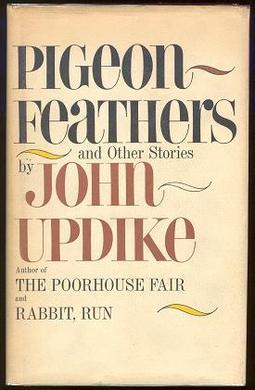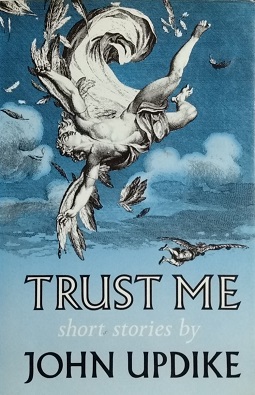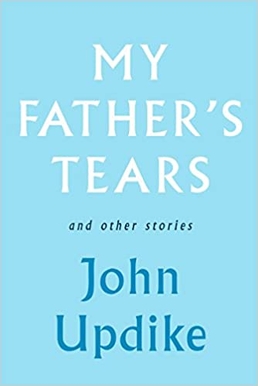The Stories
Unless otherwise indicated, all the stories first appeared in The New Yorker. [4]
"Snowing in Greenwich Village" (January 13, 1956)
"Wife-wooing" (March 12, 1960)
"Giving Blood" (March 29, 1963)
"Twin Beds in Rome" (January 31, 1964)
"Marching Through Boston" (January 22, 1966)
"The Taste of Metal" (March 3, 1967)
"Your Lover Just Called" ( Harper’s Magazine , January 1967)
"Waiting Up" (from Your Love Just Called, 1980)
"Eros Rampant" (Harper’s Magazine, June 1968)
"Plumbing" (February 12, 1971)
"The Red-Herring Theory"
"Sublimating" (Harper's Magazine, September 1971)
"Nakedness" (The Atlantic Monthly, August 1974)
"Separating" (June 15, 1975)
"Gesturing" ( Playboy Magazine , January 1979)
"Divorcing: A Fragment"(Harper's Magazine, January 1967)
"Here Come the Maples" (October 3, 1976)
Critical Assessment
Literary critic Jane Barnes places the Maple stories as among the most accomplished of Updike’s literary career:
“Too Far to Go collects all the Maple stories, the first of which was written in 1956. None of them suffers from the stylistic excesses that mark other stories —as if the Maple series were the best stories from any given stage in Updike’s developing perception… [5]
Barnes continues: “Because of the purity and sureness of the writing, the Maple stories are a clear medium for the narrator’s moral dilemma. The medium is rendered clearer still by the fact that the Maples’ experience is considered all by itself, in terms of Richard and Joan and their children. [6]
Literary critic Richard Detwieler considers the central theme of the volume “the dissolution of a marriage and the varieties of attendant suffering.” [7]
Adaptions
Too Far To Go: The Maples Stories was adapted as two-hour television movie directed by Fielder Cook in 1979. Entitled Too Far to Go the adaption starred Blythe Danner, Michael Moriarty, Kathryn Walker and Glenn Close. [8] The linked stories focus upon the marriage and eventual divorce of Richard and Joan Maple and depict a 1960s New York City and New England milieu through the 1970s typical of much of Updike's fiction. Many of the stories were initially published as occasional stories in The New Yorker from the mid-1950s to the mid-1970s. [9]
Literary critic Richard Detweiler wirtes: "The television dramatization of Too Far To Go, produced in 1979 (with Blythe Danner and Michael Moriarty playing Joan and Richard Maple), was a popular and critical triumph which demonstrated how good television, at times, can be. [10]
The story "Your Lover Just Called" was later adapted into a playlet by Updike himself. It is included in his collection More Matter (1999). Most of these stories were also included in Updike's 2003 collection The Early Stories , except those published after 1975; namely, "Waiting Up", "The Red-Herring Theory", "Divorcing: A Fragment", and "Here Come the Maples". In August 2009, Everyman's Library published The Maples Stories, a new edition of Too Far to Go, including the final Maples story "Grandparenting".

John Hoyer Updike was an American novelist, poet, short-story writer, art critic, and literary critic. One of only four writers to win the Pulitzer Prize for Fiction more than once, Updike published more than twenty novels, more than a dozen short-story collections, as well as poetry, art and literary criticism and children's books during his career.
Who Made Yellow Roses Yellow? is a work of short fiction by the novelist John Updike, first appearing in The New Yorker on March 30, 1956. It was published in his 1959 collection The Same Door.

The Poorhouse Fair (1959) was the first novel by the American author John Updike. A second edition included an introduction by the author and was slightly revised.

Of the Farm is a 1965 novel by the American author John Updike. Of the Farm was his fourth novel. The story concerns Joey Robinson, a divorced, thirty-five-year-old Manhattan advertising executive who visits his mother on her unfarmed farm in rural Pennsylvania. He has come with his new wife, Peggy and her son, Richard, a precocious eleven-year-old. The novel explores both Joey's relationship to his widowed mother, a flinty woman who reveres her farm, and to Peggy, a kind, sensual woman. Joey feels guilt for leaving his mother, and anger at her stubborn refusal to leave the farm, and anger at her from having uprooted his late father from the suburbs to move to the farm decades ago. Joey is buffeted by doubt, angst, and anger, and is pinballed between his dueling mother and Peggy.

Pigeon Feathers and Other Stories is a collection of 19 works of short fiction by John Updike. The volume is Updike's first collection of short stories, published by Alfred A. Knopf in 1962. It includes the stories "Wife-Wooing" and "A&P ", which have both been anthologized.

Trust Me: Short Stories is a collection of 19 works of short fiction by John Updike. Each story originally appeared in The New Yorker or other literary journals. The stories were collected in 1987 by Alfred A. Knopf.

My Father’s Tears and Other Stories is a collection of 18 works of short fiction by John Updike. The volume was published posthumously in 2009 by Alfred A. Knopf and is the final collection to date of Updike’s stories.

The Same Door is a collection of 16 works of short fiction by John Updike published in 1959 by Alfred A. Knopf. The stories in the volume first appeared separately in The New Yorker, some in a slightly different form than in the collection. The Same Door is Updike’s first volume of short stories.

Olinger Stories: A Selection is a collection of 11 works of short fiction by John Updike published by Vintage Books in 1964.
“Snowing in Greenwich Village” is a work of short fiction by John Updike, first published in The New Yorker on January 13, 1956. The story was collected in The Same Door (1959) published by Alfred A. Knopf.
“Pigeon Feathers” is a work of short fiction by John Updike which first appeared in The New Yorker on April 27, 1956. The story was collected in Pigeon Feathers and Other Stories (1962) by Alfred A. Knopf.

Problems and Other Stories is a collection of 23 works of short fiction by John Updike. The volume was published in 1979 by Alfred A. Knopf. The stories were first carried in literary journals, 17 of which appeared in The New Yorker. Problems and Other Stories is one of two collections of Updike's short stories that appeared in 1979.

Museums and Women and Other Stories is a collection of 25 works of short fiction by John Updike, first appearing individually in literary journals. The stories were collected by Alfred A. Knopf in 1972.
“The Music School” is a work of short fiction by John Updike that first appeared in The New Yorker on December 12, 1964. The story was collected in the volume of Updike's fiction The Music School: Short Stories (1966), published by Alfred A. Knopf.
"The Happiest I've Been" is a work of short fiction by John Updike, first appearing in The New Yorker on January 3, 1959. The story was collected in The Same Door (1959) published by Alfred A. Knopf.
“Giving Blood” is a work of short fiction by John Updike first appearing in The New Yorker on March 29, 1963. The story was collected in Too Far to Go: The Maples Stories (1979), published by Fawcett Publications.
“Wife-Wooing” is a work of short fiction by John Updike which first appeared in The New Yorker on March 12, 1960. The story was collected in Too Far to Go: The Maples Stories (1979), published by Fawcett Publications.
“Problems” is a work of short fiction by John Updike first appearing in The New Yorker on November 3, 1975. The story was collected in Problems and Other Stories (1979) published by Alfred A. Knopf.
“The Egg Race” is a work of short fiction by John Updike which first appeared in The New Yorker on June 13, 1977. The story was collected in Problems and Other Stories (1979) by Alfred A. Knopf.
“Ace in the Hole" is a work of short fiction by John Updike that first appeared in The New Yorker on April 9, 1955. The story was collected in the volume of Updike's fiction The Same Door (1959), published by Alfred A. Knopf.









